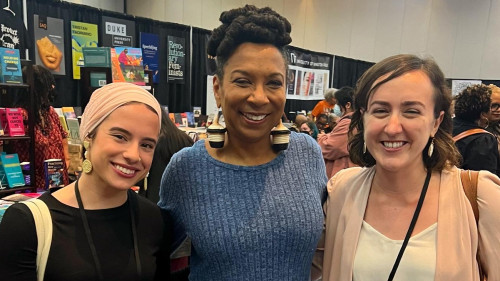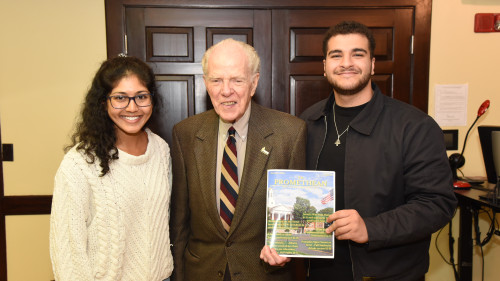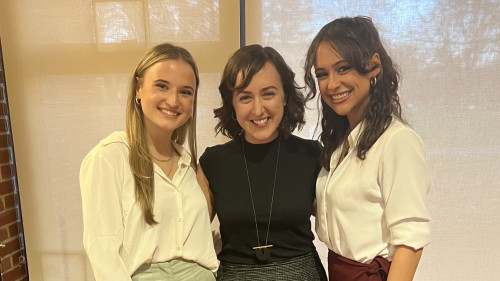
The disease seemed to come from nowhere, perplexing researchers, physicians, and elected officials and alarming the public.
That may sound sadly familiar, but back in the 1980s and 90s it was HIV/AIDS and not the COVID-19 that claimed lives and grabbed headlines all over the world. To explore that earlier global pandemic, Shannon Draucker, Ph.D., assistant professor of English, designed a new course, “HIV/AIDS in Literature and Pop Culture.” As the class learned about this deadly disease that emerged four decades ago, their lives were touched by another, newer disease. One student and her family were directly impacted.
Draucker developed the idea for the course last semester, when she taught Tony Kushner’s epic drama “Angels in America” as part of her course on “Sexuality and Literature.” The two-part Tony Award-winning play explores the issues of AIDS and homosexuality in 1980s America, and she featured it in her new course as well.
“The students were very interested in the subject of AIDS, and how it related to sexuality, race, and class. The AIDS pandemic provides a lens through which we can study many of these different vectors.”
In her new course, in addition to “Angels” the students examined Larry Kramer’s groundbreaking play “The Normal Heart” (in another coincidence, playwright and legendary AIDS activist Kramer died on May 27); and Danez Smith’s 2017 poetry collection “Don’t Call Us Dead” among other canonical works. The class also explored the disease and its impact through an intersectional lens with Sapphire’s “Push,” Jamaica Kincaid’s “My Brother,” the film version of the musical “Rent” and an episode of the TV series “Pose,” which took the conversation outside the world of gay, white middle- and upper-class American men.
“The course explored the linguistic, visual and sonic tools that artists use to portray an illness that few understand and many stigmatize,” said Draucker.
They also explored how these playwrights, poets and filmmakers consider activist movements and how to fully and truly represent an ongoing global pandemic and the different kinds of people who are impacted by it.
“Dr. Draucker’s enthusiasm to teach about different narratives regarding the virus really enhanced the experience for her students. I felt very invested in each story that we learned about,” said Madison Lemke ‘21. “In this class, the idea of intersectionality was really emphasized. For example, the black and LGBTQ community is the group that often falls victim first to a serious virus. The two groups are both oppressed yet one becomes even more oppressed when one is in both groups. The severity of this intersection leads to a horrific trend of exclusion and oppression.”
Probably no student in the class was more directly impacted by the study of pandemics than Leeney Mendez ’22. Her Bronx family was hit harshly – a loved one died in January from an illness that was later determined to be COVID-19. Then, her household faced the pandemic nightmare first hand: Mendez and her father, mother and brother were all diagnosed with the illness. They all recovered.
The final project of the course was “Art and Literature in the Time of a Pandemic,” where students were assigned to create original poetry, photography, vlogs, or films Mendez found her inspiration in her Bronx neighborhood, and took color and black-and-white photos, made a brief film, and read and wrote poetry.
“I wanted to capture how much my home changed. I had to see the life stripped away from the loudest and proudest home. At first, I didn’t pay mind to the pandemic because I thought I had all that I needed and more, until everything became personal. When our family was struck with death, I wanted to keep to myself and turn away from the world. But then I thought why not use my love for poetry to release all the anger and sadness I had bottled inside. Doing a project about the world’s pandemic and my own pandemic helped me release my emotions instead of suppressing them, while telling my story to the world.”
Zariyah Fowler, ’21 created a seven-minute movie showing the progression of the pandemic, starting from January with things being “normal,” to April in quarantine.
“I used funny videos of my friends and me with sad music in the background to make it more powerful, and to reflect the good times before COVID-19. I then featured an entire section where I acted out daily tasks to demonstrate challenges/emotions I’ve faced during this pandemic. Overall, this class allowed me to create my own personal narrative as a form of literature to tell my story.”
In their community engaged component, the class transcribed personal stories from staff and clients at the Albany Damien Center, one of the first drop-in HIV/AIDS centers in the country.
“It was such an incredible experience to visit the Damien Center and see how important of a resource it is to those with AIDS,” said Jenna Morrissey ‘21. “I was partnered with a woman who has spent her entire life fighting for the AIDS cause and has been working for the Center since the day they opened. Transcribing the interview with her was a challenging, yet enriching experience, and I feel so lucky to have been able to help her tell her story.”
Morrissey said that she and her fellow students were able to better understand those who lived during the AIDS pandemic by reading literature.
“Art is able to capture emotions and point of views in a way quite different from textbooks, which makes it much more powerful.”
Brianna Blake ’21 said the literature and culture they studied, combined with the final creative project and the outreach to the Damien Center taught her and her classmates about the impact of a pandemic.
“We went in depth about what it was like during the AIDS epidemic and the falsities and stigmas it created. We had important conversations in class about privilege and the power of speaking out about negative stereotypes about things such as the LGBTQ+ community. Dr. Draucker did not take the movies, plays, or books we were reading lightly, but even with such a heavy topic, the class was enjoyable, and I always learned something new following each and every class session."

